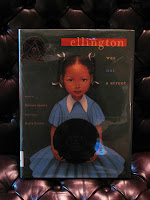Solving problems. That was the first teaching concepts that I thought of when reading this book. Lizette's Green Sock was one of the only books I could not find at my public library. I look a trip to Barnes and Noble to review the book.
| Lizette's Green Sock by Catharina Valckx Originally published in France |
This is a wonderful book about Lizette's finding a green sock on day while taking a walk. When two of her friends start to make fun of her because she only has one green sock, she begins on a journey looking for the other sock. After searching high and low at a pond and a tall tree, she heads towards home to wash the green sock because she could not find the other one. After her mom makes her a matching sock, she has one for a hat and the other sock now serves as a fish sleeping bag!
Lizette never gives up throughout the whole book. She is determined, caring and creative. These are qualities that children should read about in children's literature. Lizette came to a bump in the road but that did not stop her. She did not have to rely on anyone other than herself. She was motivated to find the missing sock.
I went to my public library and in the suggestion box I listed Lizette's Green Sock as a book to be added to the children's book section. Hopefully, in the near future I will see this title sitting on the shelf at the library.
















